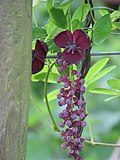bio.wikisort.org - Plant
Akebia is a genus of five species of flowering plant, within the family Lardizabalaceae. The scientific name, akebia, is a Latinization of the Japanese name for species Akebia quinata: akebi (通草).
| Akebia | |
|---|---|
 | |
| Akebia quinata | |
| Scientific classification | |
| Kingdom: | Plantae |
| Clade: | Tracheophytes |
| Clade: | Angiosperms |
| Clade: | Eudicots |
| Order: | Ranunculales |
| Family: | Lardizabalaceae |
| Genus: | Akebia Decne.[1] |
| Species | |
|
See text. | |
Species
| Flower | Name | Common Name | Distribution |
|---|---|---|---|
| Akebia apetala (Quan Xia, J.Z.Sun & Z.X.Peng) Christenh. | China, Japan, Korea, Taiwan | ||
| Akebia chingshuiensis T. Shimizu | Taiwan | ||
 | Akebia longeracemosa Matsumura | China and Taiwan | |
 | Akebia quinata (Houttuyn) Decaisne | Chocolate vine or five-leaf akebia | China, Korea and Japan |
 | Akebia trifoliata (Thunberg) Koidzumi | Three-leaf akebia | China, Korea and Japan |
Hybrids
- Akebia ×pentaphylla (Makino) Makino (A. quinata × A. trifoliata)
Fruit
Akebia quinata and Akebia trifoliata both bear edible fruit, containing a sweet white flesh.[3] Flavor varies greatly in akebias, even within the same species, with some individuals displaying a complex flavor profile resembling a mixture of banana, passionfruit and lychee, with others being mild, or even insipid.[4]
Akebia in Japan
Akebia is often mentioned in Japanese literature, where it is evocative of pastoral settings.[5] Although the akebi commonly refers to the five-leafed species, the three-leafed species is used in much the same way for novelty food, medicine, and for vine material.
While only a minor food eaten while foraging in the past, akebia is considered a specialty crop today, only available when in season. The pods contain a white, semi-translucent gelatinous pulp that is mildly sweet and full of seeds.[6] The taste is described as sweet but rather "insipid".[6] Some people recollect in idyllic terms how they foraged for it in the hills as children.[7]
The purple-colored, slightly bitter rind has been used as a vegetable in Yamagata Prefecture[7][8] or in those northern areas, where the typical recipe calls for stuffing the rind with minced chicken (or pork) flavored with miso.[8] Minor quantities of akebia are shipped to the urban market as a novelty vegetable.
In addition to consuming the fruit, akebia leaves are also made into a tea infusion.[5] Outside of food and drinks, akebia vines are used for basket-weaving crafts. An old source lists Minakuchi, Shiga and Tsugaru (now Aomori Prefecture) as localities that produced baskets from the vines of trifoliate variety.[9]
Gallery
- Ripe Akebia trifoliata fruit
- Akebia quinata leaves and flowers
- Female flowers of Akebia quinata (large) and male (small)
- Early fruit of Akebia quinata
- Akebia quinata flower
- Early fruit of Akebia quinata
References
- "Akebia Decne". Plants of the World Online. Royal Botanic Gardens, Kew. Retrieved 2020-10-10.
- "Akebia". Flora of China. Retrieved 2009-04-05.
- "Akebia quinata". PFAF.
- "Akebia: A Potential New Fruit Crop in China". HortScience.
- Davidson, Alan, and Tom Jaine. The Oxford companion to food. Oxford University Press, USA, 2006. 805. Print. Retrieved Aug. 09, 2010, from
- Sargent, Charles Sprague (March 25, 1891), "Plant Notes-The Fruit of Akebia quinata (With Figure.)" (google), Garden and Forest, 4 (161): 136
- Nimura, Kazuo(二村一夫)r (2006-07-22). "食の自分史" [Self-history on food]. 『食の自分史』. Retrieved 31 January 2017.
- Yamagata City Health Center (2011-01-31). "あけびの詰め物" [stuffed akebia]. Archived from the original on 19 October 2011. Retrieved 31 January 2017., photograph shows trifoliate variety (twig, fresh purple plant, and prepared dish)
- Agricultural Society of Japan; Dai Nihon Nōkai(author alia) (1895). Useful plants of Japan: described and illustrated (google). Vol. 1. Agricultural Society of Japan. p. 92.
{{cite book}}:|author2=has generic name (help)
Further reading
- Bailey, L. H. (2005). Manual of Gardening (Second ed.). Project Gutenberg Literary Archive Foundation.
External links
- Akebia: Three Varieties including photographs by Paghat's Garden
- Akebia: Edible Fruits including photographs by Paghat's Garden
На других языках
[de] Akebia
Akebia, zu deutsch auch Akebie ist eine Pflanzengattung in der Familie der Fingerfruchtgewächse (Lardizabalaceae).[1][2] Die etwa fünf Arten gedeihen in gemäßigten Gebieten in Bergwäldern in Ostasien (China, Korea und Japan).[1][2]- [en] Akebia
[es] Akebia
Akebia es un género con 5 especies aceptadas de plantas de flores perteneciente a la familia Lardizabalaceae.[1] El nombre científico de akebia, es una latinización del nombre japonés para la especie Akebia quinata: akebi (通草, 'akebi'?). Conocida popularmente como planta del chocolate, y cultivada por los jardineros como planta ornamental trepadora.[ru] Акебия
Акебия (лат. Akebia) — род двудольных растений, входящий в семейство Лардизабаловые (Lardizabalaceae). Родина акебии — Восточная Азия (Китай, Корея и Япония)[2].Другой контент может иметь иную лицензию. Перед использованием материалов сайта WikiSort.org внимательно изучите правила лицензирования конкретных элементов наполнения сайта.
WikiSort.org - проект по пересортировке и дополнению контента Википедии





